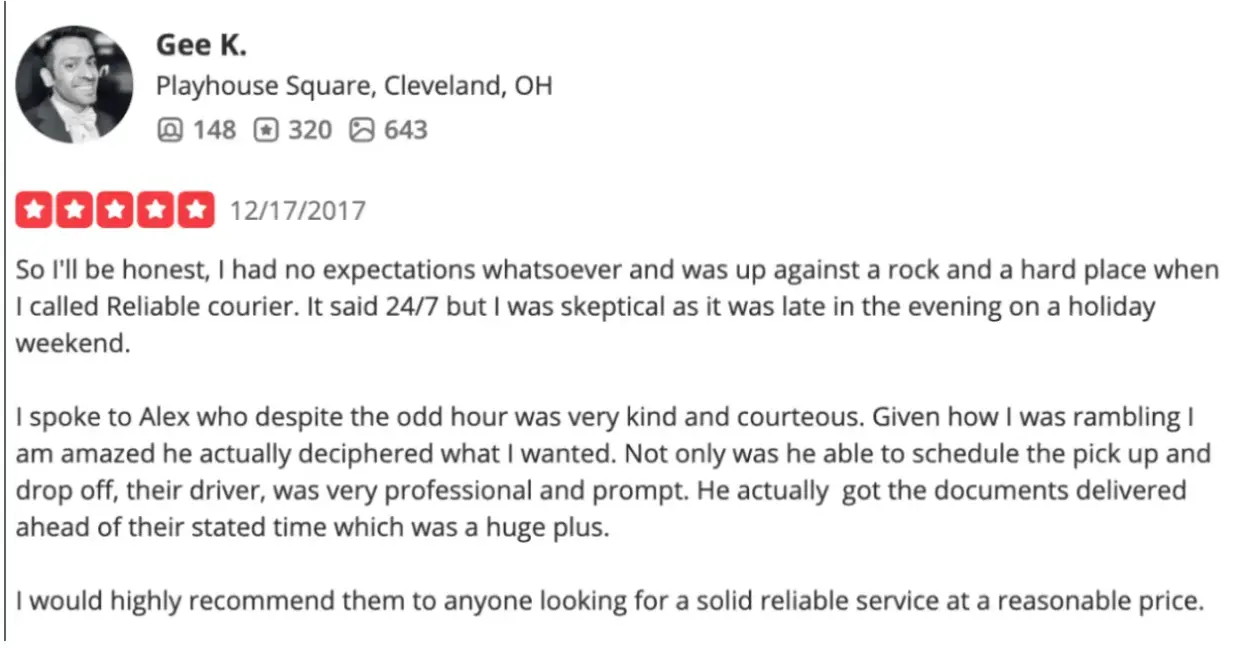It’s a little daunting how much power customers can wield over small businesses with nothing more than a seething 1-star review. How you respond to negative reviews can change everything.
You toil and sweat for years to create a business that produces value for you and your customers, and 99% of your sales go off without a hitch.
But, sometimes, things go wrong — whether it’s entirely your fault or due to something completely out of your control.
And then you get the inevitable heart-sinking email from an angry customer, threatening to take their negative experience online and burn the reputation you worked so hard to create.
It doesn't have to be like this. And not responding at all is one of the biggest marketing mistakes you can make.
Regardless of how insensitive they may seem, your customers make this threat because they’ve been separated from their hard-earned cash and are not happy with the result. Instead of lamenting this fact — use it.
5 Ways to Turn Bad Reviews Into Your Best Customer Experiences
- Acknowledge the customer and accept fault.
- Utilize the service recovery paradox
- Create a workflow for review processing
- Prepare tangible benefits as a show of contrition
- Always remember the power of kindness
1. Acknowledge the customer and accept fault.
The first point is a philosophical one. It’s easy to be a little trigger-happy when you see a nasty customer review roll in. We get defensive over the things we worked hard to create.
“They don’t know the first thing about the economics and logistics of this game; how dare they!”
But consider this — have you ever left a negative review? Why? Did you have sympathy for that business owner, and how hard they worked when you did?
The fact of the matter is most people are only driven to leave a bad review when the experience described didn’t match the experience received.
Their interaction with your service didn’t justify the cash they dropped on it — and that is a problem.
So, the first thing to mention when dealing with bad online reviews and testimonials is this. You should generously consider every bad review a reflection of a systemic problem in your business, even if it doesn't appear to be at first glance.
With this perspective, an offshoot of the age-old adage of ‘the customer is always right,’ you’ll always put yourself in a position to improve your services.
And, at the very least, you’ll end up minimizing the chances of a similar type of negative review coming in.
Having an exceptional customer service approach such as the one Reliable Couriers has will allow you to avoid bad reviews from the get-go and get positive ones like the following example:
Functionally, it’s rare for customers to be truly badly intentioned. Don’t get me wrong; these people do exist.
But if 0.01% of your customers want nothing more than fire and brimstone, that’s simply not enough to justify an equally guns-blazing approach.
Consider bad reviews a jumping-off point for improvement, which brings us to our first recovery concept.
2. Utilize the service recovery paradox
The most powerful tool in your armory when dealing with negative online reviews is the “service recovery paradox,” first identified in 1992 by McCollough and Bharadwaj.
The service recovery paradox is the notion that customers who had bad experiences with your company will think higher of it if their experience is rectified compared to if they had no issues at all.
Yep, your brand reputation could be improved due to a negative customer experience on the condition that you make efforts to resolve the issue and improve the system that created it.
Take the following example from Tailor Brands, an AI-powered logo design and branding platform.
It seems they ran a promotion for a free logo if certain conditions were met by the prospective customer (signing up for a paid subscription to the site).
Having signed up, the customer went on to download their logo only to discover that it was a low-res version, which was below the customer’s expectations. Their review, published on a well-known company experience review site, was damning.
They responded with the following:
Whether or not the conditions of the promotion were made clear to the customer before signing up is irrelevant to our purposes.
What’s important is how Tailor Brands used the situation to its advantage. They were swift and effective in their recovery efforts, taking the matter to private communications and rectifying the oversight (probably by offering a hi-res version of the logo).
Naturally, the customer updated their thoughts — this time back in the public forum, demonstrating the service recovery paradox to future potential customers.
In the business, we call that a “win-win.”
3. Create a workflow for review processing
At a certain point, as your customer base grows, you will reach a point of statistical inevitability — for a lot of things. But, most relevantly, for terrible customer experiences.
As we mentioned earlier, even if you did everything right, there is a certain type of customer who just wants to watch the world burn.
They might be hunting for money off, refunds, and other incentives. They may just be having a bad day. But they’re there, whether you like it or not. So, instead of politely asking them to seek therapy, operationalize it.
These things are going to happen, so it’s an operational priority for you to have a reliable, repeatable workflow that deals with negative customer reviews effectively and efficiently — especially with large-scale customer bases.
What is a workflow? It’s essentially a set of operational instructions that offers guidance on the best path to take when something occurs within a business.
The above example maps out a workflow for a typical purchase order approval. It takes the form of a flowchart, which allows the operator to take the correct approach based on the conditions set every single time without cooperation from a superior.
Read more about making a flowchart in Word.
Think about how you could apply this to the case of bad customer experiences.
This should be bespoke to your particular business, as each one has different methods of successfully dealing with customers, and only you can decide what that is based on your experiences.
Using tools such as an advanced web browser like Stack can help make this process quite simple, as it allows you to navigate between different pages or CRM apps with ease while adapting to your specific needs within a straightforward UI.
In fact, a lot of companies use workflows when managing their customer communications, especially in industries that rely heavily on technologies like business voip, which help streamline responses and ensure quicker resolution times.
In most cases, the workflow will result in you offering the customer a kind of benefit that evens out the value exchange that has asymmetrically benefited the business in the customer's eyes.
4. Prepare tangible benefits as a show of contrition
You’ve probably heard the phrase “money talks.” It really couldn't be any more appropriate in this context.
Money literally talks when customers leave bad reviews. It’s rarely just because their experience could have been better.
Most of the time, a customer leaves a bad review because they feel they have been treated unfairly due to parting with cash for an experience that didn’t justify the cost.
In this way, you can consider money as the key variable — which is quantifiable. This means that you can easily turn a bad experience into a normal, or even positive one, just by balancing the books.
No, we’re not saying you should stuff your customer’s mouths with hush-hush money every time a bad review comes in. “Money” can mean a lot of different things within the universe of products and services.
Percentage discounts on future purchases, partial refunds, shipping refunds, reward points, and loyalty stamps.
These are all examples of where value sits within your business, and customers appreciate these benefits just as much as cold, hard cash if they’re reliant on your services.
Ever reported a terrible experience to Uber? Nine times out of 10, you get an instant 10% discount on your next ride.
Uber has an automated workflow that doles out these promotions without any human influence at all. And how quickly we forgive it all as a result of $5 saved on a ride, you’re inevitably going to take.
Make a list of all the ways you can offer shows of contrition to your customers and match them with common bad experiences.
Next time a customer complains about long delivery times, you’ll know straight away that a shipping refund will do the trick.
5. Always remember the power of kindness
Here’s a wholesome tip to round off the list. What if your worst customer experiences could turn into your best reviews? That would certainly be making the best out of a bad situation.
Remember — even when the customer is dead wrong, they may as well be right. Treat them with more kindness, respect, and compassion than they deserve, and you might be able to coax some nice words out of them in return.
We call that “killing them with kindness.” Take this bone-chilling, all-caps email from a customer of vegan gift hamper service My Vegan Hamper as an example:
Clearly, the customer isn’t happy with the delivery partner for this company (which may be a slight understatement).
But there’s not much they can do about that — it’s effectively out of their hands after a product is fulfilled.
Except, by keeping in close communication with the customer, listening closely to their specific complaints, and being as kind and patient as a Tibetan monk, they can calm the storm.
The situation was resolved, and the customer went on to leave one of the company’s most powerful reviews to date:
Become a Master of Bad Review Responses
All is not lost when a bad review rolls in. It could be a powerful opportunity to turn your biggest haters into your most fervent fans and improve your services at the same time.
Just remember never to fight fire with fire. Accept responsibility (even when you’re not totally at fault), figure out the course of action that will make it right, and systematize that response to put dealing with bad customer reviews in ‘auto’ mode.
Author Bio
Vikas Kalwani manages partnerships at uSERP and actively mentors portfolio companies of 500 Global. He is a product-led growth marketer and B2B marketing specialist skilled in SEO, content marketing, and social media marketing.



